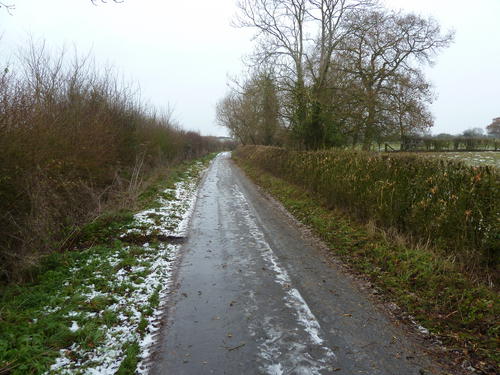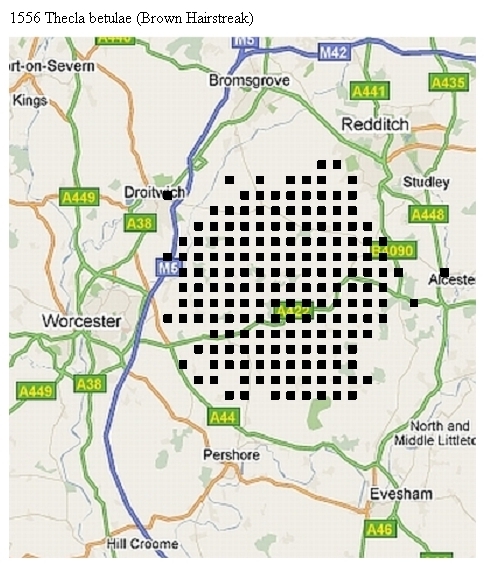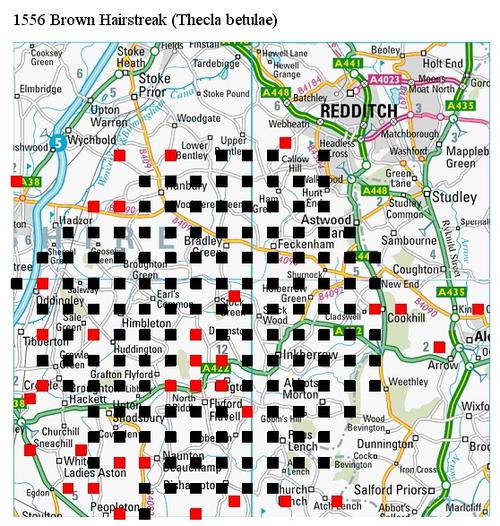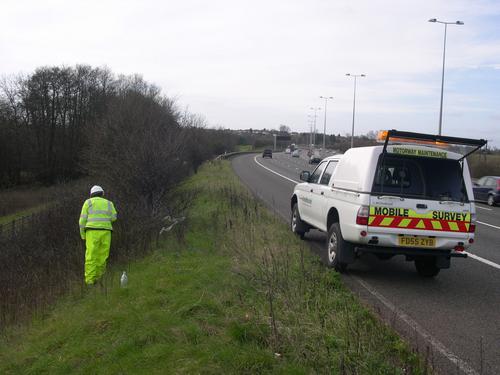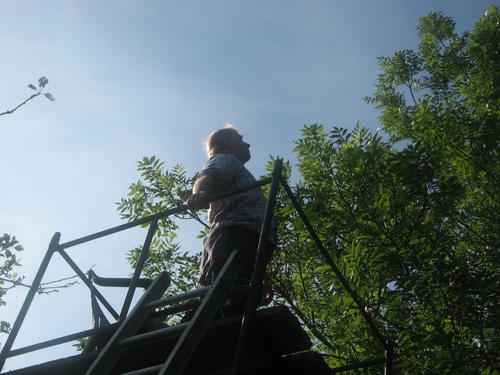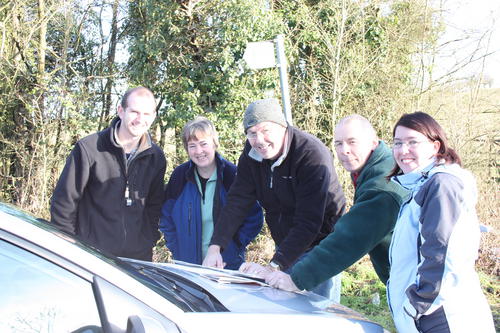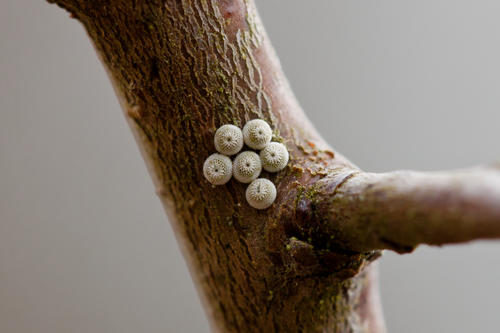Where next for the Brown Hairstreak Thecla betulae?
Mike Williams
It was back in 2006 (Worcestershire Record Number 20, April 2006) that I last reported on the county’s most elusive butterfly so a further update seems timely. At that point, we had recorded Brown Hairstreaks in 108 1x1km squares over a wide area of east Worcestershire bounded by Redditch to the north, Pershore to the south, the county boundary to the east and the M5 motorway to the west. The butterfly is difficult to spot as an adult but it lays its eggs on blackthorn (normally singletons), where they remain throughout the winter and, with practice, these can be located fairly easily. We have actually seen adult butterflies in less than 10% of recorded squares: all the rest of our records are based on finding eggs. Through West Midlands Butterfly Conservation a band of volunteer “Hairstreak Champions” have been recruited and trained to search for eggs and our current knowledge of the distribution and status of the Brown Hairstreak is a result of their commitment and dedication. Venturing out in the depths of winter to search hedgerows for objects the size of a pinhead can be viewed perhaps as an extreme form of butterflying but, nevertheless, it has proved surprisingly productive. So much so, that the number of known 1x1km squares where the butterfly has been found has now grown to 179. Each winter, new squares have been added and our evidence suggests that the butterfly is still expanding its range in the county, possibly in response to climate change, but no doubt helped to a more limited extent by agri-environment schemes that have encouraged farmers to cut more hedgerows on rotation. Over the years Butterfly Conservation has worked closely with Natural England to encourage better hedgerow management on farms, latterly through the promotion of Higher Level Stewardship, although recent cuts in budgets makes this option less likely at least in the short term. It sadly still remains the case, however, that the vast majority of eggs laid by every female Brown Hairstreak are lost to annual hedge flailing. Searching for eggs, especially post-Christmas, can be a pretty depressing experience with relatively few hedges having escaped the flail.
This last winter (2010-2011) has proved particularly good for finding new areas for the Brown Hairstreak with 17 additional new 1x1km squares added to our distribution map. Most of the expansions in range have been to the north-east and south with several new squares added near Redditch and around Bishampton and Church Lench. Many of these are areas, we have searched in previous years with no success and finding eggs can therefore be seen as evidence of genuine range expansion. One should not run away with the idea, however, that we are turning up eggs in every place we look. I would estimate this winter that we have only found eggs in around 1 in 4 of the squares searched. We worked hard, for example, to locate eggs along the 49th parallel south of the Lenches which would have been a new 10x10km square for the Brown Hairstreak but with no luck. Redditch itself certainly invites further investigation with places like the public amenity area around Walkwood Coppice on the edge of the town full of excellent looking blackthorn and we are keen to hear from recorders who may be willing to help search this area next winter. Towards Worcester, we have been much less successful in locating new egg squares, apart from around White Ladies Aston, and the M5 still acts as a largely impenetrable barrier to the west.
We did have hopes of a major breakthrough over the M5 after a report of an adult being spotted in the Waitrose supermarket car park in Droitwich last October but, so far, we have not been able to follow this up with the discovery of eggs west of the motorway. Back in 2006, we had a report of another adult being recorded virtually under a motorway bridge near Oddingley which resulted in us obtaining permission from the Highways Agency to search the verge of the motorway itself, which is perhaps another form of extreme butterflying. Interestingly, we found lots of suitable blackthorn on the carriageway south of Droitwich but unfortunately no eggs, although the Highways Agency, as a result of our survey, did agree to manage their blackthorn on rotation. Any records of brownish- orange butterflies recorded out of a speeding car window in September, however, are unlikely to be accepted without further evidence! An adult sighting over the county boundary at Kings Coughton, in contrast, did result in us finding only the second modern egg record in Warwickshire along the edge of Old Park Wood with other nearby records for Worcestershire around Cladswell and Cookhill. Searches in this area in future years will perhaps give us a better idea of whether this was merely a female with a poor sense of direction or whether this is the start of a further expansion of range to the east.
A new area of research over the past five years has been into the Brown Hairstreaks’ use of so-called assembly trees. It has been found that on emergence at the end of July, male Brown Hairstreaks head for prominent ash trees usually situated in a hedgerow or along the edge of a wood. Here, the males set up territories and await the arrival of females which generally emerge some days later. Courtship and pairing takes place around the canopy of the trees and, after the eggs have matured, the female disperses to lay her eggs on nearby hedges. Locating assembly trees is not easy as the main flight period for the males appears to be very early in the morning and after around 9.30 am activity eases off so, in order to observe behaviour, it is very much a question of making an early start and being in the right place at the right time. Occupancy of the assembly trees only occurs for a relatively short period of weeks and it is very rare to find males beyond the end of August. We have found that the ideal tree has an easterly aspect where it catches the first rays of the morning sun. Trees of medium height, perhaps 15-25 feet, appear to be favoured with an uneven canopy offering some degree of shelter. The same trees are often also used by Purple Hairstreaks Favonius quercus so binoculars and telescopes are required in order to check that the butterflies are indeed Brown Hairstreaks. Often, the butterflies are extremely active at this time of the morning, only settling for an instant before shooting off in pursuit of another butterfly, which does not make this task any easier. Perhaps, not surprisingly in view of the above, only a handful of assembly trees have been located so far but we have found that Brown Hairstreaks are faithful to particular trees and the same trees are used every year. The place that assembly trees play in the overall ecology of the Brown Hairstreak is only partly understood. Our admittedly limited evidence suggests that proximity to an assembly tree may influence the density of eggs laid with females laying most eggs on blackthorn relatively close to the tree. If this is indeed the case, it should help us to locate further trees in the future. We also suspect that assembly trees may play an important role in enabling the Brown Hairstreak to expand its range with occupancy of a new tree being a first stepping stone to colonising new areas. Further work is planned over the summer to follow up leads on possible new assembly trees within east Worcestershire and to discover more information on this fascinating aspect of butterfly ecology.
If any county recorders are interested in helping to unravel further the mysteries of the Brown Hairstreak do get in touch by email: mike@stagborough.fsnet.co.uk An ebulletin is regularly sent round to all interested in keeping up to date with all the latest information on the Brown Hairstreak and anyone wishing to be put on the mailing list for this should contact me via the same email address.
Images
Fig. 1. Flailing miles of hedgerows at the same time destroys many Brown Hairstreak eggs. Rotational cutting is best. ©Mike Williams
Fig. 2. Known Brown Hairstreak distribution in Worcestershire at March 2011. Each black square represents a 1x1km square.
Fig. 3. Brown hairstreak distribution as figure 1 but with latest 2010-2011 records in red.
Fig. 4. Searching blackthorn for Brown Hairstreak eggs along motorway verges. ©Mike Williams
Fig. 5. Early morning watching for Brown Hairstreaks at an assembly ash tree. ©Mike Williams.
Fig. 6. Brown hairstreakers about to set off on a winter egg hunt.
Fig. 7. Brown Hairstreaks lay their eggs on young blackthorn shoots. They are normally laid singly, occasionally in pairs, but during the 2010-2011 winter clusters of two to seven were found – reasons unknown.
